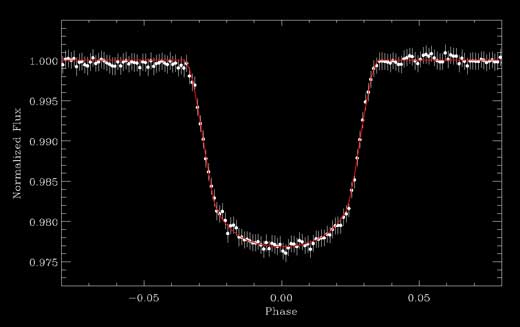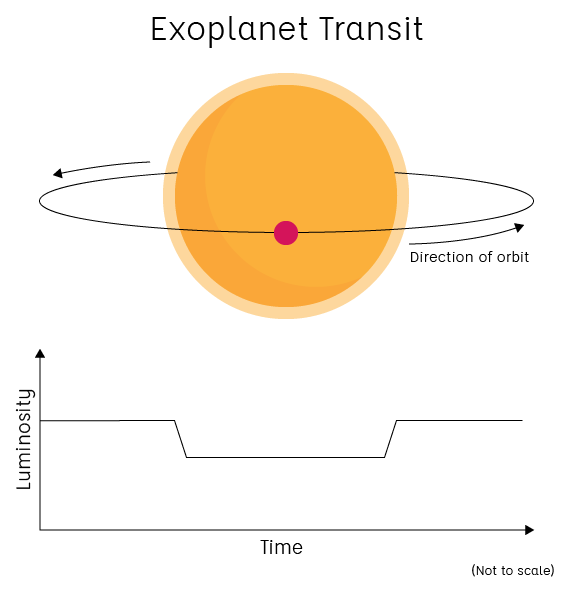
One of the most exciting aspects of astronomy is searching for life on distant planets. If found, it may help scientists to understand how life arose on Earth about 3.5 billion years ago. As our planet is the only place in the universe known to sustain life, scientists hypothesise that alien lifeforms would require the same conditions: a rocky planet with liquid water.
Detecting planets outside our solar system – i.e. exoplanets – creates a challenge. Compared to stars, exoplanets are much smaller and do not emit any light. How can scientists find these small, non-luminous bodies?
The key lies in precisely measuring the light emitted by distant stars. CoRoT (COnvection ROtation and planetary Transits) was the first mission in space focused on exoplanet discoveries, which fuelled breakthroughs in stellar physics. Consisting of a 27 cm diameter telescope and a camera that takes a picture every 32 seconds, CoRoT acquired high cadence, quasi-uninterrupted, and long-duration photometric observations of crowded stellar fields.

Simultaneously observing up to 12,000 stars, CoRoT is pointed in the same direction for more than 150 days at a time, before the Earth’s movement around the Sun leads to the unwanted effect of the Sun’s rays entering the telescope. CoRoT then turns 180 degrees around its long axis and points in the other direction. Credit: ESA
Originally planned for a two-and-a-half-year mission, CoRot launched in 2006 and was granted two mission extensions, eventually deorbiting in 2014. The project was led by CNES, with contributions from ESA, Austria, Belgium, Germany, Spain and Brazil. To reduce development time and associated costs, CoRoT was built on the Proteus bus, the same satellite platform used for other missions with Teledyne technology: CALIPSO, Goktuk 1A & B, Jason 1 & 2, and SMOS.
Convection and Rotation
Both stars and planets start as collections of gasses and dust. A protostar – the ‘seed’ from which a star grows – forms as gravity collapses this matter together. As the prostar gains mass, the force of gravity increases, exerting pressure and thus increasing temperature. After millions of years, the core temperature reaches conditions at which nuclear fusion can begin, officially forming a star.
As stars burn, they generate hot gasses which rise to the surface. Strong magnetic fields inhibit this convection, reducing the temperature of those areas and creating dark starspots on the star’s surface. Starspots are essentially the same as the sunspots we have detected on our sun with the exception that we can better characterise sunspots due to detailed observations from missions like Hinode and SDO.
The convection from the stellar dynamo causes the intensity of the light it emits to increase or decrease by a few parts per million as starspots rotate into view. Furthermore, monitoring the starspots tells us how fast the star is rotating.
This stellar variability was a longstanding issue in stellar physics. CoRoT observes each star over a long period of time. The on-board computer then measures the light fluctuations from each star to produce a light curve. Analysis of these spectral lines helped astronomers identify the frequencies and patterns of stellar oscillations. This information can then be used to infer the star’s internal structure, composition, and evolutionary stage.
Prior to CoRoT, only a handful of seismic constraints were available for only a few of the closest, biggest, or brightest stars. CoRoT greatly expanded the depth of information gathered, and opened the way to a complete description of the thousands of stellar systems observed around ours, including the relation between the star and the planets of these systems.
Planetary Transits

This plot shows the transit of the first exoplanet discovered by CoRoT: CoRoT-Exo-1b. The transit results in a decrease in the luminosity of the Sun-like parent star when the planet passes in front of it every 1.51 days. It is a very hot Jupiter-like giant planet, similar to Jupiter also in mass (as determined by spectroscopic observations from the ground) and 1.49 +/- 0.08 times Jupiter’s radius. Credit: ESA.
When a planet in orbit around a star passes between the CoRoT satellite and the star, it can be detected as a small dip occurring periodically in the star’s light output; a process known as transit photometry. The shape of the light curve tells us how the planet is moving, how the outer layers of the star behave, and also the size of the planet. CoRoT can detect planets that are close to their star – taking up to 50-75 days to circle it and can find planets as small as Earth.

Example of an exoplanet transit. Credit: LCO
Starspots will also cause a dip in brightness and can mimic a planetary transit. Stars normally rotate over a period of days while planet transits last a few to tens of hours. Thus it is essential to determine the stellar rotation for proper differentiation.
Once a planet has been detected by CoRoT, astronomers can learn even more detailed information about it – such as mass and density – by observing the star and its planetary system with other instruments on ground telescopes. One prominent instrument is the High Accuracy Radial velocity Planet Searcher (HARPS) spectrograph attached to the 3.6m telescope at the European Southern Observatory’s La Silla Observatory in Chile. These complimentary observations reveal more information on the nature of the transiting body – potentially including orbital eccentricity – than can be determined by using space or ground instruments alone.
A more detailed analysis of planets parameters help infer the planets’ composition. Accurate masses and radii enable the estimation of the amount of heavy elements in a very large diversity of gaseous planet structures. Combining CoRoT’s quality photometry with intense, dedicated follow-up, has been valuable to explore the orbital evolution of some systems and to set constraints on the planet migration and theories of tidal interactions.
Astroseismology
CoRoT also conducted astroseismology; detecting acoustical waves – called starquakes – generated deep inside a star that send ripples across its surface and alter its brightness. Analysing the ripples allows astronomers to calculate the star’s precise mass, age, chemical composition, and internal structure. In 2008, it became the first mission to detect a starquake in a star other than the Sun.
Observing the activity of stars harboring planets is useful because magnetic conditions on the star's surface could influence the habitable zone, where life could develop. Stellar seismology helps scientists better understand the processes driving magnetic activity and how magnetic cycles can differ from star to star – including our own Sun and its influence on Earth's climate. It may also lead to better predictions of the solar cycle and resulting geomagnetic storms that can cause major disruption to power grids and communication networks.
The CoRoT Instrument

Credit: CNES/LESIA
CoRoT uses a wide-field, two-part camera – half for the seismology mission, and half for the exoplanet mission – with a focal plane consisting of four Teledyne CCD42-80 detectors. They were frame-transfer, thinned, back-illuminated detectors presenting 2048 × 2048 pixels in the image zone, and a memory area of 2048 × 2054 pixels, with each pixel being 13.5 × 13.5 μm2 in size. A prism, to acquire color images of the stars, was installed before the exoplanet field which enabled astronomers to distinguish the stellar activities of a planetary transit for the brightest stars. One half of the camera was designed to look for planets; the other half was optimised to detect the subtle variation in a star's light, caused by sound waves rippling across the surface.
For the seismology mission, the image spot for a star will be spread out on about 400 pixels, with an exposure time of 1 second.
Results
CoRoT acquired more than 163,000 light curves and detected about 500 planet candidates. Like many astronomy missions, the data collected by CoRoT continues to be analysed. So far, astronomers have confirmed 32 exoplanets, two brown dwarfs – failed stars that cannot support nuclear fusion, and one unique object, CoRoT-3b whose exact nature, light brown dwarf or massive planet, remains an open question. Another notable discovery was the exoplanet CoRoT-7b, discovered in 2009, which became the first exoplanet shown to have a rock or metal-dominated composition.
CoRoT boosted our current understanding of stars and particularly of red giants. Massive planets have been found around host stars that are at odds with the regular solar-type stars on which radial velocity surveys concentrate: fast rotators, active stars and even a case of a planetary system whose host star exhibits pulsations.
CoRoT established proof of concept, and developed subsystems for two additional missions featuring Teledyne sensors: the upscaled Kepler mission, and CHEOPS.
Works Cited
C. Moutou, M. Deleuil, T. Guillot, A. Baglin, P. Bordé, F. Bouchy, J. Cabrera, S. Csizmadia, and H.J. Deeg. (2013). CoRoT: Harvest of the exoplanet program. Icarus, Volume 226, Issue 2. https://doi.org/10.1016/j.icarus.2013.03.022.
CNES. (2025, January 20). CoRoT. https://cnes.fr/en/projects/corot
ESO - Astronomy & Astrophysics. (2009). The CoRoT satellite in flight: description and performance. A&A 506, 411–424. DOI: 10.1051/0004-6361/200810860
The European Space Agency (ESA). (n.d.). COROT Overview. https://www.esa.int/Science_Exploration/Space_Science/COROT_overview
Malcolm Fridlund. (2009, December 9). The CoRoT satellite: the search for Earth-like planets. Science in School - Issue 13. https://www.scienceinschool.org/article/2009/corot/
Meg. (2013, February 11). Starspots and Transits. Planet Hunters. https://blog.planethunters.org/2013/02/11/starspots-and-transits/
Nancy Atkinson. (2010, August 26). Sound Waves from Distant Star Reveal Magnetic Solar Cycle. Universe Today. https://www.universetoday.com/articles/sound-waves-from-distant-star-reveal-magnetic-solar-cycle
T. Guillot and M. Havel. (2016). CoRoT’s planets: A family portrait. The CoRoT Legacy Book. DOI: 10.1051/978-2-7598-1876-1.c033
Teledyne Technologies. (2024, June). The Search for Exoplanets. https://www.teledyne.com/digital-imaging-space-science-monthly/the-search-for-exoplanets
